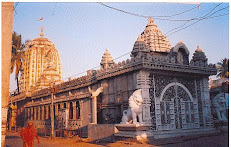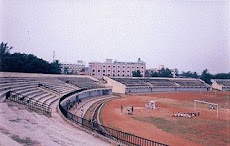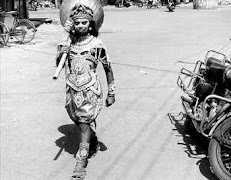OLD BERHAMPUR: GOLDEN MEMORIES OF MY TIMES (Part XVIII)
By Vinnakota Venkata Sankar Rao (V V Sankar Rao)
======================================================
======================================================
Prayer to Lord Shiva by self-torturing is evident from Treta Yuga and is also mentioned in Bhaghavata Purana and other Puranas. Some people believe that these are superstitions of people and imposed by the upper caste on others over the generations. However, it is not so. The reality was different. Even Mahavira Jina, Jaina Digambaras, Buddhist Monks and Tantric Sadhakas in the Hindu pantheon always believe in Penance. The followers of Islam also practice self-torturing to please their almighty.
Lord Brahma sat penancing to redeem himself from the curse of Lord Shiva for his arrogance in creating the universe. Lord Shiva appeared in front of him from the ears of a cow. So that place is known as Gokarna which is about 480 KMs from Bangalore and 240 KMs from Mangalore on sea shores of Arabian Sea. As per religious believes, Lord Parusurama, the 6th Avatara of Lord Vishnu, created Kerala from Gokarna to Kanyakumari.
During Treta Yuga, Ravana’s mother, a devotee of Lord Shiva, used to make a Shiva Linga with sea sand daily in the early morning in Lanka for the long life and welfare of her son Ravana. Lord Vishnu with the help of Sea God used to wash away the shivalinga and disturb her Pooja. As such Ravana decided to pray to Lord Shiva to obtain his Atma Lingo and wanted to bring it to Lanka permanently. He approaches Kailash and prays to Lord Shiva, but failed to please him. Then Ravana decided to tear off the intestine of his body and use it as “Veena” and start praying to Lord Shiva. Lord Shiva was very pleased with the way Ravana made self-inflicted injury to his body. Lord Shiva offers him his “Atma linga” with a condition that it should not be placed on the earth until he reaches his destination.

Ravana begins his return journey to Lanka. On knowing this, Lord Vishnu wanted to prevent him from taking “Atma linga” to Lanka, since once it reaches and his mother starts worshiping no one can stop Ravana. Lord Vishnu approaches Lord Ganersha for help. Lord Ganesha appears as a cowherd and Lord Vishnu by using his “Sudarsan Chakra” stops the view of Sun God so that Ravana felt it is evening and that the sun is about to set. Ravana had the habit of offering “Jalanjali” to the Sun God at its rise and set without fail. At that point he has reached “Gokarna” sea shore. As he could not place the “Atma linga” on earth, he approaches the cow-herd (Lord Ganesha ) to hold it until such time he completes the rituals. Lord Ganesha makes a condition that he cannot wait for a long period and before he puts it down will call him thrice and he should come before that to take the “Atma linga” from him. While Ravana was still performing his rituals, Lord Ganesha calls him thrice and places the “Atma linga” on the earth. Despite best efforts Ravana fails to move the “Atma linga” from the place where it is kept. Ravana seeks help of Vali to shift “Atma Linga” since Vali has the capability of drawing the strength from his opponent to him, but Vali also fails to shift. While making his efforts Ravana could succeed to remove some pieces of linga and throws them and they fall at different places. These places are known as Dhareshwara, Gunavanteswara, Murudeseara and Shejeshwara. As Ravana could not even tilt the linga, he called it is “Mhabala” and as such Lord Shiva is also known as “Mahabaleswara” and these places is also known as “Pancha Keshtras”
Some of them also torture themselves during this period by beating themselves with hunter and normally they apply haldi all over their body. I have also seen people piercing their tongue by a needle. First time I have seen some Bhaktas at “Sarankul” Ladubaba Mandir in Nayagada District of Odisha piercing their tongues during my child hood and that was my first memory and I was almost frightened and hid my faces in the anchal of my mother. At that time I was about four years or so. During this period the Bhaktas also perform walking on fire. Some of them will also make “Angapradakshana” (they will move around the temple in Srastanga Namaskara pose for about 13 or 21 or 108 times). These self-inflecting injuries they make to pay homage to Lord Shiva for saving the lives of their dear ones.
Similarly “Chhau Nrutya” a form of dance cum martial arts to worship Lord Shiva is also being performed in Mayurbhanj and Chattishgarh. The difference between the two is that in Chhattisgarh they wear masks and also pour kirosine on the mask and lit fire and dance in front of Shiva Lingo in darkness of course guided by some of other participants. In case of Mayurbhanj the dance form is also mixed with that of Odishi and they won’t wear masks. Once Maharaja of Mayurbhanj Srirama Chandra Bhanj Deo and Pratap Chandra Bhanj Deo presented the famous “War Dance” in 1912 at Calcutta (now known as Kolkata) in honor of George V, the British Emperor and the appreciations were showered by King, press and elite for their performance of “Chhau Dance”.
I have given all these examples to show as a tradition of self inflicting injuries to one’s own body to please Lord Shiva is from the days of Treta Yuga. I have illustrated this story to show the existence of such form of worship to Lord Shiva in all most all religions.
Danda Nata is also a penance and one of the major theatrical form of devotion of Ganjam District associated with the Shiva cult. It has its roots in the religious and cultural history of Odisha. It is essentially ritualistic folk theatrical in nature and associated with Shiva, Kali myth. The Danda (penance) elucidates the Rudrakali myth associated with the activities of Lord Shiva and Kali. Its origin is traced to 8th or 9th centuries after the decadence of Buddhism. After this the Shaivism became predominant in Odisha. The downtrodden, untouchable and low cast people took to the worship of Lord Shiva outside the temples. They started for their salvation to Lord Shiva once in a year during “Chaitra” by performing dance called “Danda Nata”. Abhinava Chandrika a literary work of 1568 has also mentioned about “Danda Nata”.
To be continued ---------------------------------------------------------------------
- About the Author-
(The writer was born in 1946 at Berhampur, studied at KC High School near Khallikote College abd later that school migrated to Gusainuagaon as KC Higher Secendary School., later studied at Khallikote college and obtained degree in 1968 from Berhampur University.
I joined State Bank of India as Clerk-Typist in 1970 at Berhampur. and left Berhampur in 1979 on transfer. Again I came to Berhampur and worked as Field Officer and also Branch Manager at SBI, Aska Road Branch, Berhampur during 1988 to 2001.
There after my visits to town as a guest for a day or two. I served in places like Surada , Koraput, Sunabeda. Sundargarh, Barpali and Bubanesweaw. Finally retired in 2006. Since 2011 I am staying in Bangalore.)



























.jpg)

















































